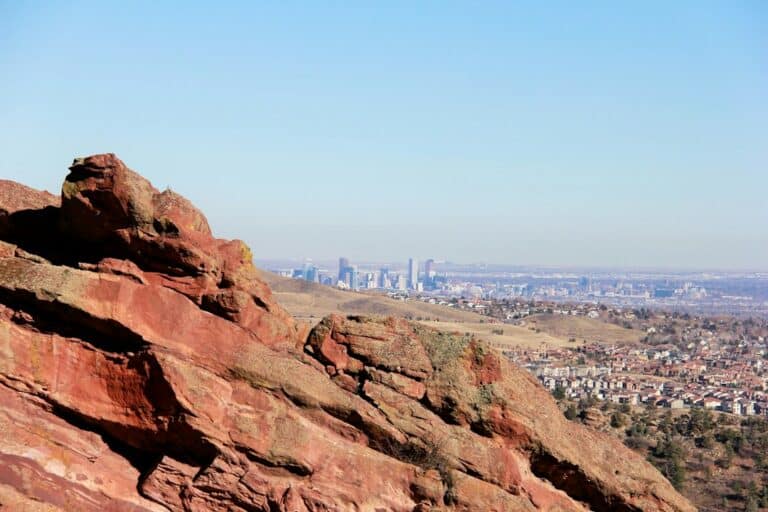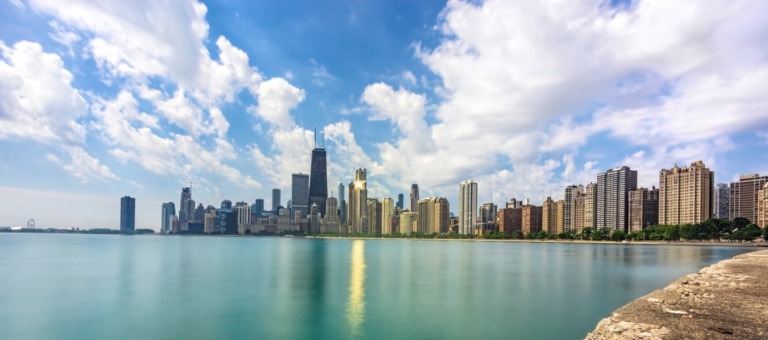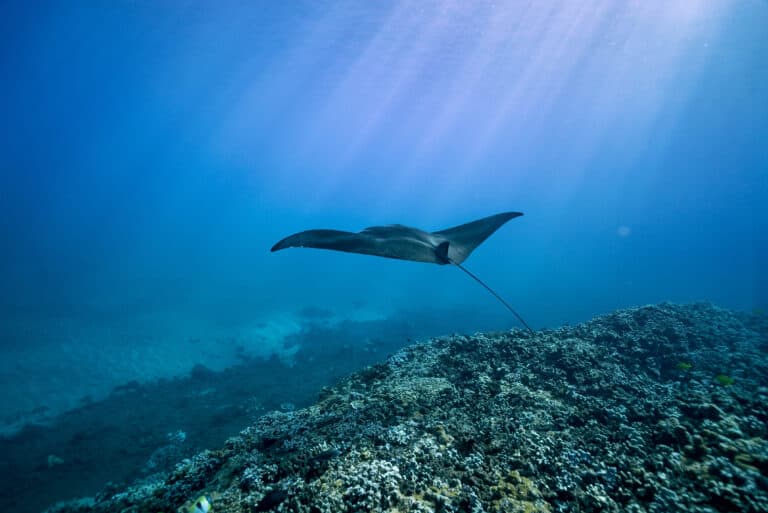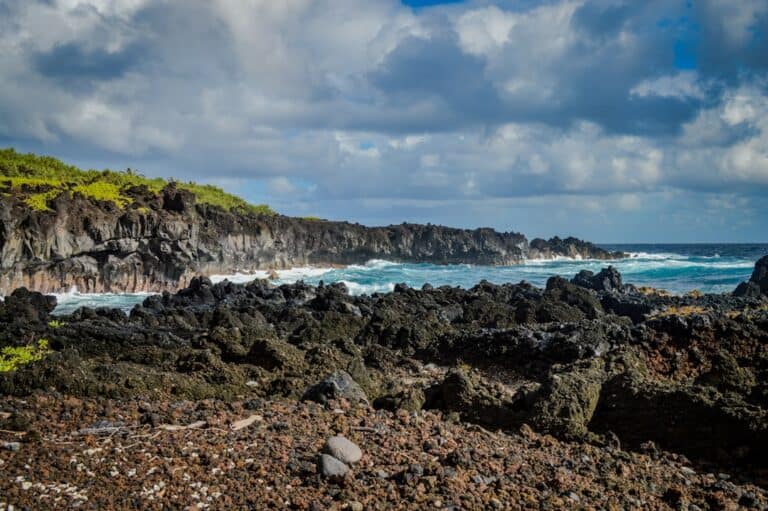Discover the 15 Best Hikes in Hawaii: From Volcano Treks to Beach Trails
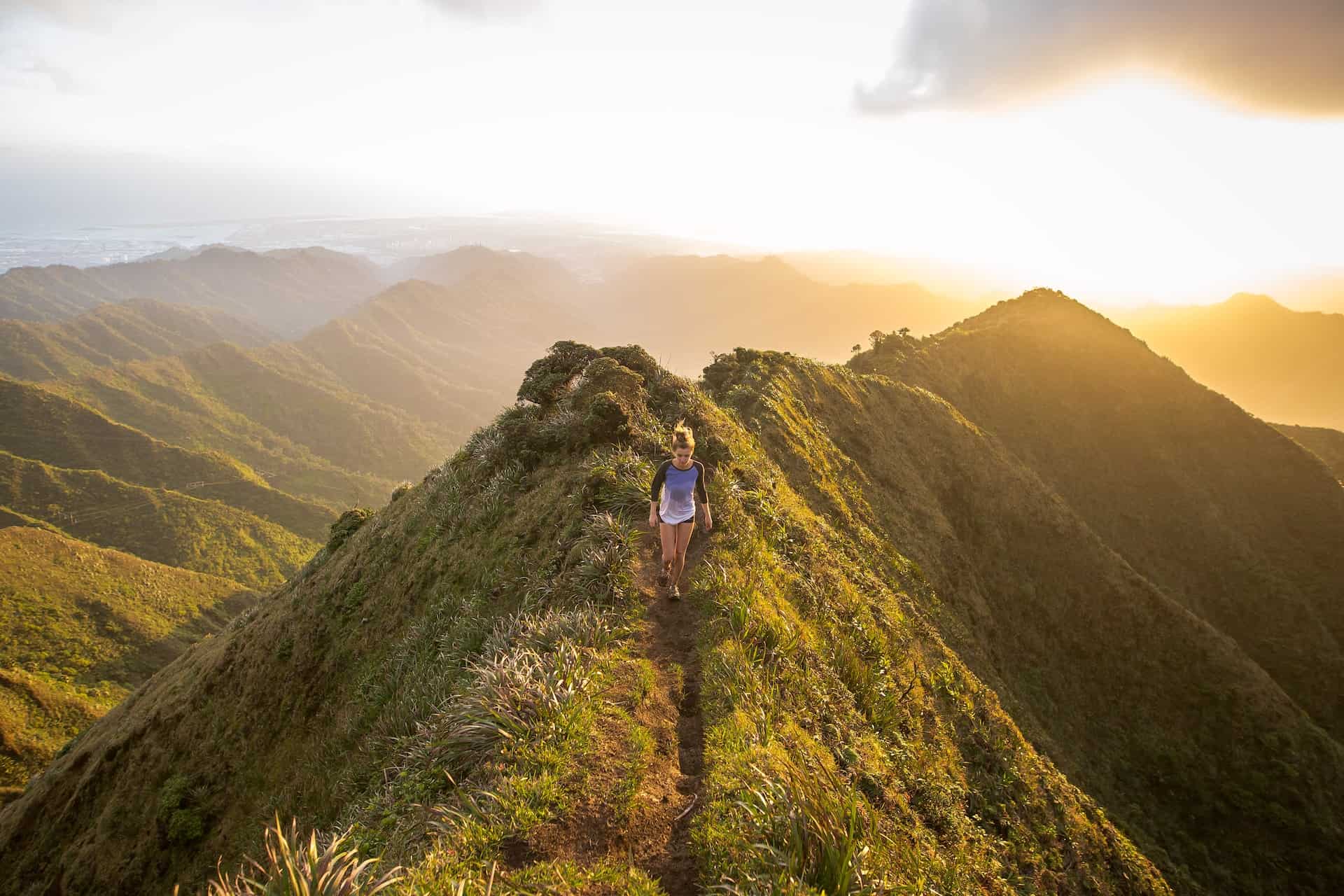
Hawaii, the jewel of the Pacific, is not just about pristine beaches and swaying palm trees.
It’s a haven for adventure seekers and nature enthusiasts, offering diverse hiking opportunities.
As you explore this tropical paradise, you’ll discover that Hawaii is not just a destination; it’s a hiker’s dream come true.
With its rugged volcanic landscapes, lush rainforests, and mesmerizing coastal trails, Hawaii promises an unforgettable outdoor experience.
From the fiery depths of volcanoes to the tranquil beaches lapped by crystal-clear waters, this archipelago in the Pacific Ocean is a paradise for those who yearn to lace up their hiking boots and hit the trails.
In this guide, we’ll take you on a journey through the 15 best hikes in Hawaii.
From the iconic to the hidden gems, each hike offers a unique glimpse into the natural beauty of these islands.
So, gear up and prepare to embark on an adventure as we explore the diverse landscapes and breathtaking vistas of Hawaii’s best hikes.
Best Hikes in Hawaii: Things to Consider

Hiking in Hawaii promises unforgettable adventures, but your safety should always take the front seat. Whether you’re a seasoned hiker or just starting, a few vital considerations can make your outdoor experience enjoyable and secure.
- Never Hike Alone: No matter how confident you are, hiking with a buddy is always safer. Let someone know your hiking plans, expected return time, and trail route. It’s an extra layer of security.
- Respect Trail Boundaries: Hawaii’s beauty is for all to enjoy, but that doesn’t mean you can trespass on private property. Stick to marked trails and heed warning signs. It not only ensures your safety but also protects the environment.
- Pack Essentials: Nature can be unpredictable, so it’s wise to be prepared for anything. Carry an adequate food and water supply to keep you energized and hydrated throughout your hike. Sturdy, comfortable footwear is a must, and don’t forget essentials like a jacket, sunscreen, and mosquito repellent.
- Expect the Unexpected: Hiking takes you into the wild, where surprises can happen. From encountering wildlife to trail mishaps or getting lost, it’s best to be ready for any scenario. Basic knowledge of first aid and navigation can be invaluable.
- Crime Awareness: While Hawaii is a paradise, it’s not immune to crime. Don’t leave valuable items in your car, not even in the trunk, when you head out for a hike. Keep your belongings secure to ensure a worry-free adventure.
Remembering these essential tips, you’ll enjoy Hawaii’s stunning landscapes and ensure a safe and memorable hiking experience. Now, let’s dive into the 15 best hikes this beautiful archipelago offers, each with unique charm and allure.
1. Makapuʻu Point Lighthouse Trail, Oahu

Photo by: Kaleismith
- Elevation Gain: 560 feet
- Difficulty Level: Easy to Moderate
- Distance: 2 miles (roundtrip)
- Cost: Free
The Makapuʻu Point Lighthouse Trail on Oʻahu’s easternmost edge offers stunning views of the Kaiwi Coast and the Pacific Ocean.
This 2-mile round-trip hike takes about an hour to complete and is perfect for beginners or even parents with strollers.
The paved trail makes it accessible to non-hikers, pets, and strollers.
The trail’s highlight is the Makapuʻu Point Lighthouse, built in 1909 and standing on a 600-foot-high sea cliff.
From November to May, hikers can witness North Pacific humpback whales as they journey to these warm waters for mating, play, and birthing.
Although attempting to access the lighthouse is illegal, the trail offers an excellent vantage point for whale watching from land.
Be sure to wear thick-soled shoes due to kiawe plants in the area that have thorns up to 1 inch long. Get ready for a scenic adventure in Hawaii’s backyard!
2. Kuliʻouʻou Ridge Trail

- Trail Length: 7.1 kilometers
- Estimated Hiking Time: About 3 hours
- Difficulty: Intermediate
- Elevation Gain: 600 feet
- Park Hours: Sunrise to Sunset
- Fee: None
- Parking: No parking at the entrance; look for street parking on Kalaau Rd. and in the surrounding neighborhood.
If you’re up for a challenge, the Kuliʻouʻou Ridge Trail on Oahu awaits.
Stretching over 7.1 kilometers (approximately 4.4 miles) round trip, this trail takes an average of 3 hours to complete.
It’s considered a demanding hike with an intermediate difficulty level.
What sets the Kuliʻouʻou Ridge Trail apart is the challenging terrain and the scenic rewards it offers.
As you navigate this trail, you’ll notice its popularity among hikers.
It’s an excellent choice for those seeking a more strenuous workout amidst breathtaking natural beauty.
The trail begins where you’ll find the Kuli’ou’ou trail state hiking sign at the end of Kalaau Rd.
Make sure to follow the dirt path rather than the paved road.
Along the way, you’ll encounter diverse plant life and varying surroundings, making the journey as intriguing as the destination.
As you lace up your hiking boots for the Kuliʻouʻou Ridge Trail, prepare for a rewarding trek through the lush landscapes of Oahu.
Recommendations for Hikers
- Look for pink ribbons along the trail; they guide you if you feel disoriented or lost.
- Follow the dirt path to the top of Koolau Ridge, where you’ll be rewarded with awe-inspiring views of Oahu’s South and East Shores.
- This trail is open year-round, so choose a time that suits your schedule and preferences.
- Dogs are welcome on the trail and maybe off-leash in some areas, making it a great spot for furry friends to enjoy nature.
- Expect a mountainous dirt trail with steps along the way, adding to the challenge and adventure.
3. Koko Crater

Photo by: Eric Tessmer
- Trail Length: 2.6 kilometers (approximately 1.6 miles)
- Estimated Hiking Time: About 1 hour and 24 minutes
- Difficulty: Moderate to Difficult
- Elevation Gain: 990 feet
- Cost: Free
- The trail is open year-round, providing opportunities for exploration at any time.
Koko Crater, much like its sibling, Diamond Head, is a geological wonder created by the ancient Koʻolau Volcano.
However, it holds a unique history that sets it apart.
During World War II, the U.S. military constructed bunkers atop the crater and even developed a railroad system for access.
Today, the Koko Crater trail takes you along the remnants of this defunct railway, making it a fascinating journey into Hawaii’s wartime past.
As you traverse this 2.6-kilometer (about 1.6 miles) out-and-back trail, the challenging terrain may give less experienced hikers a run for their money.
But fear not, for the breathtaking view of Hanauma Bay from the summit makes every step worthwhile.
The Koko Crater trail is generally considered a challenging route, with moderate to difficult difficulty.
The ascent involves an elevation gain of 990 feet, offering a formidable workout for hikers seeking adventure.
Your journey will take you through a landscape that showcases Hawaii’s rugged beauty, with panoramic views of the surrounding area.
The allure of this hike lies not only in the summit but in the history etched into the very path you walk.
Safety Tips
- Ensure you’re physically prepared for a demanding hike, as the trail can be quite strenuous.
- Wear appropriate hiking footwear with good traction, as some sections can be steep and rocky.
- Carry sufficient water to stay hydrated throughout the hike.
- Be cautious of the challenging terrain and exercise care, especially on the descent.
- Dogs are prohibited on this trail, so plan accordingly if you have furry companions.
4. Waihee Ridge Trail (Maui)

Photo by: Xavier Lubeigt
- Trail Length: 6.4 kilometers (approximately 4 miles)
- Estimated Hiking Time: About 2 hours and 49 minutes
- Difficulty: Challenging
- Dogs are welcome but must be on a leash.
The Waihee Ridge Trail on Maui offers a hiking experience unlike any other.
Spanning 6.4 kilometers (approximately 4 miles) as an out-and-back trail, it’s considered a challenging route that takes an average of 2 hours and 49 minutes to complete.
What sets this hike apart is the enchanting blend of lush surroundings and panoramic vistas.
As you navigate this snaking ridge, you’ll be treated to vast views of the West Maui mountains, also known as Mauna Kahalawai.
The trail unfolds a tapestry of plant life that changes with every step in elevation, making it a captivating journey for nature enthusiasts.
Birdwatchers will find a haven here, as the Waihee Ridge Trail boasts a remarkable diversity of avian life.
The hike culminates at Lanilili, a small hill that reaches 2,500 feet above sea level.
Here, your effort is rewarded with magnificent views that stretch in every direction, providing a visual feast for the eyes.
The Waihee Ridge Trail is open year-round, offering opportunities for exploration in every season.
However, to make the most of your experience, consider starting early on a sunny day.
Maui’s weather can be unpredictable, and an early start helps you beat the clouds that tend to build as the day progresses.
The staggering views from the trail are a sight to behold, especially on clear days.
Watch for Mount ‘Eke, the highest point in the West Maui mountains. It appears as a high plateau and harbors one of the most unique ecosystems in Hawai’i.
As you conclude your hike and head back, exercise caution on the descent, especially if the trail is muddy, as it can become quite slippery.
5. ʻAiea Loop Trail

Photo by: ALAN SCHMIERER
- Trail Length: 4.8 mile loop
- Difficulty: Easy to Moderate
- Terrain: Forested and Open Ridge
- Elevation Gain: 900 ft
For those seeking a hike that’s not overly strenuous but immerses you in the serene beauty of a lush forest, the ʻAiea Loop Trail is a perfect choice.
This 7.2-kilometer (approximately 4.5 miles) loop trail near Aiea, Oahu, is generally considered a moderately challenging route.
It’s a well-loved area for camping, hiking, and running, so expect to encounter fellow outdoor enthusiasts.
The trail is open year-round, allowing you to enjoy its natural charm at any time. Dogs are welcome but must be leashed, ensuring a safe and enjoyable experience.
As you embark on this journey, you’ll be surrounded by native trees and plants, creating a tranquil atmosphere.
This loop trail runs along the west side of Hālawa Valley, offering captivating views of Pearl Harbor, Diamond Head, and the Ko‘olau Mountains.
The best part? Since it’s a loop, every step brings a different view, keeping the experience fresh and engaging.
While ʻAiea Loop Trail may not provide sweeping summit views like other Ko‘olau trails, it offers unique perspectives.
As you hike, you’ll enjoy a bird’s-eye view of the H-3 Freeway as it traverses the pristine Hālawa Valley.
This lookout point, which reveals the H-3, comes midway through the hike and can be spectacular.
Remember that this trail is popular among runners, although mountain biking is prohibited.
While runners are encouraged to yield the right of way to hikers, be aware that they may approach swiftly, so stay vigilant.
The trail’s condition can vary, especially if it has rained recently, leading to muddy sections. Being prepared for these conditions is essential for a comfortable hike.
Planning and Preparation Advice
- Allow about three hours to complete the hike, which covers nearly five miles with gradual inclines and a stream crossing.
- Check the weather before planning your hike, as recent rain can muddy the trail.
- Parking is ample at the trailhead, and restrooms are available at the Keaīwa Heiau State Recreation Area, where the trail begins.
- If you’re up for a more challenging adventure, consider branching onto the Kalauao Trail, a 4-mile hike leading to a popular waterfall with swimming holes. Be prepared for an uphill journey back, offering a cardio workout to remember.
As you conclude your hike on the ʻAiea Loop Trail, you’ll find a sense of serenity and fulfillment amidst the beauty of nature.
And for a delightful reward, The Alley Restaurant (and its famous lemon crunch cake) is just a short three-mile drive away.
6. ʻAkaka Falls State Park (Big Island)

Photo by: Pedro Szekely
- Elevation Gain: 100 feet
- Difficulty: Easy
- Distance: 1 mile roundtrip
- Cost: Fee to enter the park and paid parking
ʻAkaka Falls State Park, located along the northeastern Hilo Coast of the Big Island, is a natural gem that unveils the splendor of two magnificent waterfalls on one short hike.
This relatively easy trail offers an opportunity to immerse yourself in the lush beauty of Hawaii’s rainforest.
The ʻAkaka Falls Loop Trail is a part of ʻAkaka Falls State Park, known for its natural grandeur and accessibility.
This loop trail covers a mere 1-mile roundtrip, making it an excellent choice for hikers of all levels.
The trail includes some stair sections, which should be noted as they may pose challenges for some individuals.
Within the state park, essential amenities such as restrooms and trash cans ensure a comfortable and convenient visit.
It’s worth mentioning that there is a fee to enter the park and paid parking.
As you embark on this short but rewarding journey, you’ll be greeted by lush rainforest surroundings adorned with wild orchids, bamboo groves, and draping ferns.
The well-maintained, paved footpath leads you through this natural wonderland.
Your hike begins with a view of the impressive 100-foot Kahuna Falls.
Continue along the loop trail, and you’ll be treated to the awe-inspiring sight of ʻAkaka Falls.
This majestic waterfall plunges a remarkable 442 feet into a stream-eroded gorge, making it one of the most famous waterfalls on the island of Hawaiʻi.
The hike is a delightful experience that typically takes less than an hour, making it an accessible and worthwhile addition to your Big Island adventure.
The ease of access and the captivating beauty of ʻAkaka Falls make it a must-visit destination for nature lovers and anyone seeking the tranquil allure of Hawaii’s natural landscapes.
With ʻAkaka Falls State Park, you can enjoy the splendor of Hawaii’s waterfalls in a convenient and picturesque setting.
As you explore this natural wonder, you’ll discover the serene beauty that defines the Big Island’s northeastern Hilo Coast.
Let’s continue our exploration of Hawaii’s top hiking spots, each with its unique allure and adventure awaiting discovery.
7. Kaiwa Ridge Trail (a.k.a. the Lanikai Pillbox Trail), O‘ahu

Photo by: Deb Nystrom
- Elevation Gain: 686 ft
- Difficulty: Hard
- Distance: 2.6-km out-and-back
- Duration: 45 – 60 mins roundtrip
- While there is no designated parking area, you can locate a spot along the roadside.
- Leashed dogs are welcome on this trail.
The Kaiwa Ridge Trail, known as the Lanikai Pillbox Trail, offers an iconic Hawaiian hiking experience that combines historical significance with breathtaking ocean views.
This moderately difficult trail spans 1 mile, making it a manageable one-hour adventure.
The trail begins with a steep section characterized by loose gravel, gradually becoming more manageable as you progress.
It’s an out-and-back hike that spans 1.76 miles and gains approximately 686 feet in elevation.
As you ascend this trail, you’ll come across two concrete pillboxes: observation stations built in the early 1940s.
These pillboxes add a touch of history to your hike, reminding you of World War II.
The highlight of this trek is the opportunity to witness a stunning sunrise over the renowned Lanikai Beach and the twin islands of Na Mokulua.
The vibrant hues of the sky and the tranquil waters create a visual spectacle that’s nothing short of mesmerizing.
To reach the Lanikai Pillbox Trail, you’ll want to park at Kailua Beach Park, which offers convenient facilities like restrooms and showers.
From there, it’s just a short five-minute walk to the trailhead.
During your hike, be prepared to feast your eyes on the breathtaking turquoise waters of Lanikai Beach, the enchanting Mokulua Islands, and the imposing Koolau Mountains.
These vistas are a testament to the natural beauty that Hawaii has to offer.
If you’re an early riser, this trail is perfect for a pre-sunrise adventure.
The pillboxes offer panoramic views of the Mokulua Islands, creating a truly magical sunrise experience.
However, this trail doesn’t have lighting and can be challenging after dark, so daytime hiking is recommended. It’s a good idea to carry a headlamp in case of unforeseen delays that might keep you on the trail after sunset.
After completing your hike, consider spending some time at Lanikai Beach.
You can relax, rent paddleboards or kayaks, or swim in the clear waters.
For a satisfying post-hike meal, head to Kono’s Northshore, where you can savor their famous Kalua pig nachos or a hearty sandwich, followed by an incredible milkshake.
8. Diamond Head Crater (Lēʻahi) Summit Trail

Photo by: Eric Tessmer
- Elevation Gain: 500 feet
- Difficulty Level: Easy to Moderate
- Distance: 2 miles (roundtrip)
- Cost: Fee to enter the park
Diamond Head, also known as Lēʻahi, holds a special place in the heart of Oahu, often referred to as “The Gathering Place.”
This iconic landmark boasts natural beauty and historical significance, adding depth to your hiking experience.
The Diamond Head Crater (Lēʻahi) Summit Trail invites you to explore the remnants of an eruption over 500,000 years ago.
Managed by the Hawaii Department of Land and Natural Resources State Park Division, this US national monument offers a moderately challenging trail covering a distance of two miles roundtrip.
As you ascend, you’ll encounter steep terrain that includes a set of stairs.
While the hike may present some challenges, it remains accessible to many hikers, making it a popular choice for those looking to immerse themselves in natural beauty and history.
Insider Tips for Diamond Head
- The park’s fee should be noted before embarking on your journey.
- Diamond Head gained additional recognition in the 2014 “Godzilla” film, making it a recognizable backdrop for movie enthusiasts.
- As you explore the trail, watch for historical markers and informative signs illuminating the crater’s geological history.
- It’s advisable to wear comfortable and sturdy shoes, as the terrain can be uneven and steep in places.
- Remember to bring essentials like water, sunscreen, and a hat to ensure a comfortable hike.
- The summit rewards you with breathtaking panoramic views of the island and the Pacific Ocean, making it a prime spot for memorable photos.
- If you plan to visit during peak hours, consider arriving early to secure a parking spot and avoid crowds.
The Diamond Head Crater Summit Trail combines natural wonder and historical significance, offering a fulfilling hiking experience that’s both enriching and visually stunning. As we continue our exploration of Hawaii’s top hiking destinations, each trail unveils unique facets of this beautiful paradise.
9. Canyon Trail to Waipo’o Falls, Koke’e State Park, Kekaha, Kaua’i, Hawaii
Length: 4.8 km
Elevation Gain: 329 m
Route Type: Out & back
Explore Kaua’i’s Koke’e State Park on the 4.8-km Canyon Trail to Waipo’o Falls.
This moderately challenging hike takes 2 hours and 1 minute to complete and offers stunning views of an 800-foot waterfall.
Don’t miss out on the best experience, visit between October and February.
Enjoy a memorable family hike with stunning scenery and photo opportunities in Koke’e State Park.
Encounter native plants and birds, but be prepared for muddy terrain. Follow “Leave No Trace” principles and pack out all trash.
Hike the Canyon Trail to Waipo’o Falls for breathtaking views and to help preserve this remarkable destination.
10. Kilauea Iki Trail and Crater Rim Trail at the Hawaiʻi Volcanoes National Park (Big Island)
- Elevation Gain: 400 ft
- Difficulty: Moderate to Difficult
- Distance: 4.5 miles (roundtrip)
- Cost: Fee to enter the park
Get ready for an extraordinary adventure as you step into the heart of the youngest and most active volcano on the Big Island—Kīlauea.
The Kilauea Iki Trail and Crater Rim Trail offer a unique hiking experience that takes you across the crater floor, where you’ll walk on the remnants of a lava lake that once roiled with molten rock in 1959. It’s a front-row seat to witness the fascinating process of cooling and solidifying lava.
This 5.1-km loop trail near Volcano, Hawaii, is generally considered moderately challenging.
The route provides a captivating journey into the heart of Kīlauea and allows you to explore its dramatic landscape.
As a popular hiking destination, expect to share the trail with fellow adventurers. The trails remain open year-round, ensuring you can experience the volcanic wonder of Kīlauea at any time.
According to Native Hawaiian beliefs, Kīlauea is not just a volcano; it’s the sacred abode of Pele, the volcanic deity.
She is regarded as family and holds the status of an ʻaumakua, akin to a guardian spirit.
As you hike through this remarkable volcanic terrain, you are treading on the ground infused with cultural and natural significance.
Safety Considerations Exploring an active volcano requires a keen awareness of safety. Before embarking on these trails, make sure you’re prepared:
- Check Conditions: Stay informed about the current volcanic activity and trail conditions. The safety of visitors is a top priority.
- Be Weather-Wise: Hawaii’s weather can change rapidly. Dress in layers and bring essentials like water, snacks, and rain gear.
- Stay on Marked Paths: Stick to designated trails to avoid unstable terrain and potential hazards.
- Respect the Environment: Preserve the fragile volcanic ecosystem by not disturbing rocks or plants.
- Leave No Trace: Carry out everything you bring with you. Protect this unique environment for future generations.
While dogs aren’t allowed on these trails, the experience of hiking through a live volcano is an unforgettable adventure.
Pay your respects to Pele, take in the breathtaking volcanic vistas, and savor the wonder of Kīlauea’s remarkable landscape. Enjoy your hike, but do so responsibly and safely.
11. Hanakapi’ai Beach via the Kalalau Trail (Kauai)

Photo by: Brian
- Length: 6.0 km
- Elevation gain: 372 m
- Route type: Out & back
- Difficulty: Hard
The Kalalau Trail leads to the beautiful Hanakapi’ai Beach in Ha’ena State Park, Kaua’i.
The 6.0-km out-and-back trail offers stunning natural beauty but is challenging and takes about 2 hours and 20 minutes to complete.
The trail is open year-round but unsuitable for dogs. The first two miles of the Napali Coast trail offer sweeping views of the coastline, Kee Beach, and the coral reef.
The Kalalau Trail offers a picturesque journey with coastal and valley views, freshwater streams, and waterfalls.
The hike ends at Hanakapiai Stream, a refreshing oasis.
Crossing the stream via boulders leads to a rocky terrain beach, ideal for sunbathing and exploring hidden caves.
Swimming is not recommended due to safety concerns.
The beach offers magical views of the valley.
The hike to the falls through a bamboo forest can extend the journey to 8 miles round-trip.
Exercise caution during heavy rains and high surf, as the trail can be dangerous. Safety should be a top priority.
12. Sliding Sands Trail Haleakalā (Maui)

- Elevation Gain: 2,795 ft
- Difficulty: Difficult
- Distance: 11 miles (roundtrip)
- Entry fees: $30 for vehicles, $25 for motorcycles, and $15 per person for foot or bike entry. The annual park pass for Haleakalā costs $55.
Explore the Sliding Sands Trail in Haleakalā National Park on the island of Maui for an unforgettable adventure.
The trail takes you through an otherworldly landscape with sparse vegetation, creating a surreal ambiance.
The initial part of the trail leads downhill along the spectacular Sliding Sands Trail, showcasing unique silverswords and awe-inspiring extraterrestrial landscapes.
However, note that this hike is challenging and not recommended for children or individuals feeling unwell.
The Sliding Sands Trail in Haleakalā offers stunning views of the lush grasslands and wildflowers.
This difficult-rated trail is best suited for experienced hikers and leads to the Halemau’u overlook.
You can camp at the Holua cabin for added adventure.
The trail is accessible year-round, making it a great option to witness the sunrise and sunset spectacles that Haleakalā is famous for.
13. Wailea Oceanfront Boardwalk (Maui)
- Elevation Gain: 42 m
- Difficulty: Easy
- Distance: 5.6 km Out & back
The Wailea Oceanfront Boardwalk on Maui is a 5.6-km out-and-back trail providing captivating ocean views and opportunities for diverse activities.
This paved coastal path leads to Wailea Point and offers five public beach access points, including Wailea Beach.
The boardwalk is equipped with convenient amenities such as parking areas, showers, and restrooms, making it accessible to many visitors.
It’s an ideal spot for whale watching and accommodates various preferences, including those using mobility equipment or strollers.
Whether you seek a peaceful walk, a brisk run, or a whale-watching adventure, the Wailea Oceanfront Boardwalk welcomes you year-round to savor the beauty of Maui’s coastline.
14. Puupehe (Lānaʻi)

Photo by: Kirk K
- Elevation Gain: 134 ft
- Difficulty: Easy
- Distance: Less than one mile (one-way)
- Cost: Free
Visit Puupehe, one of Lānaʻi’s most iconic landmarks, on a leisurely hike only 20 minutes from Manele Bay.
This geological wonder, rising 80 feet from crystal-clear waters, symbolizes Lānaʻi’s most beautiful and tragic love stories.
As you approach Puupehe, be mindful of the ground nests of the native and endangered wedgetail shearwaters.
The hike offers stunning coastal views, rocky cliffs, and tide pools. Sunsets at Puupehe are particularly mesmerizing.
Accessing Puupehe is easy and suitable for all ages. Begin your hike from Hulopoʻe Beach and the rocky tide pools, tread lightly and preserve the delicate ecosystem.
Don’t miss the opportunity to explore this captivating landmark and its story.
15. Mānoa Falls Trail (Oahu)
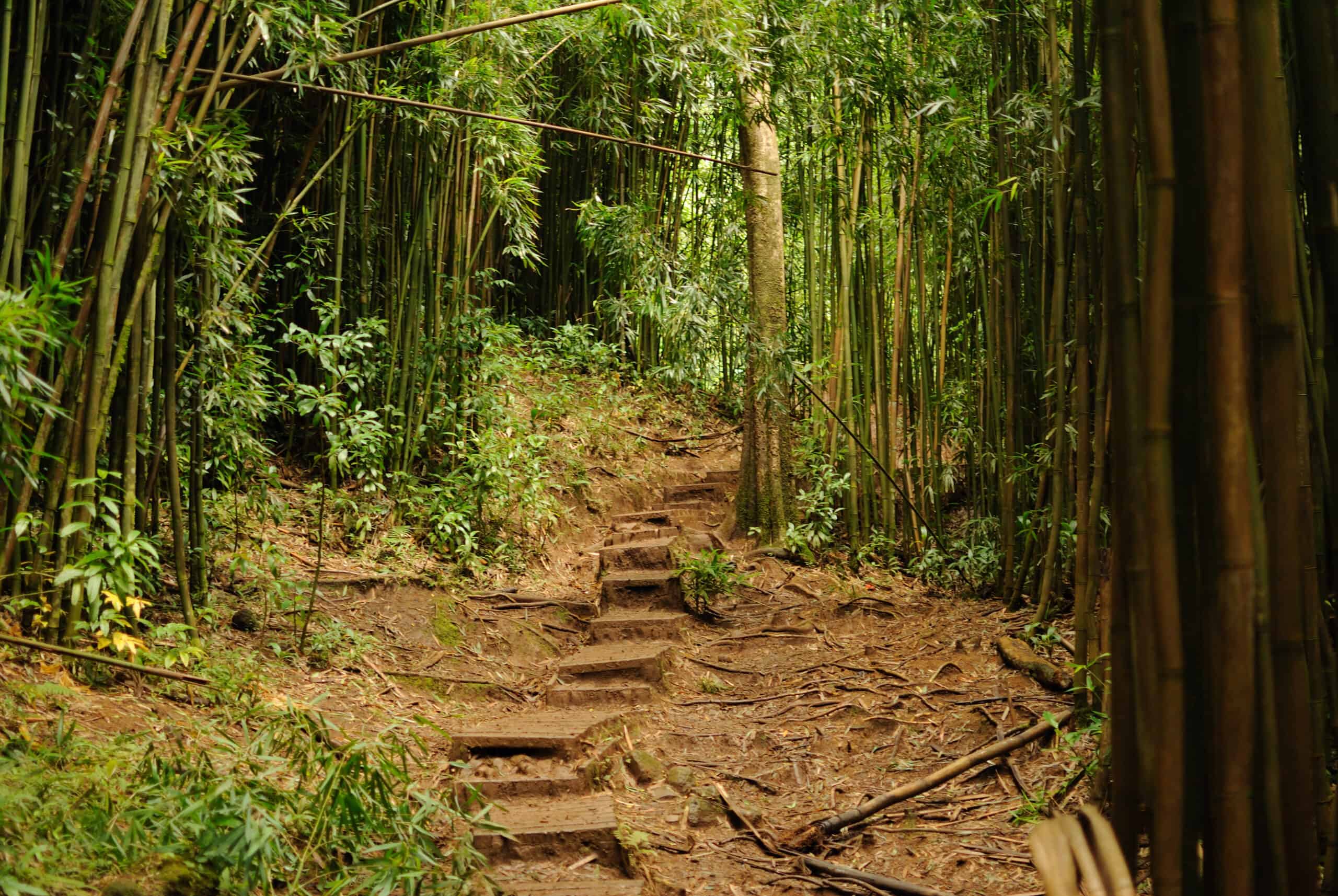
Photo by: Daniel Ramirez
- Elevation Gain: 633 ft
- Difficulty: Easy
- Distance: 1.5 miles (roundtrip)
- Cost: Paid parking
Visit Mānoa Falls Trail for a short but enchanting journey through a lush Hawaiian tropical rainforest.
You’ll recognize the picturesque landscapes that graced the silver screen in iconic movies.
The trail is open from sunrise to sunset, but avoid starting in the late afternoon for safety reasons.
Caution is required, especially at the summit. Remember, swimming in the pools at the base of the falls is prohibited due to bacterial disease.
Proper footwear is recommended, as the trail can be muddy. Check the weather before embarking to avoid potential flash floods.
The trailhead is easily accessible from downtown Honolulu, and a parking fee is required.
FAQs: Hiking in Hawaii
Q1: What is the famous illegal hike in Hawaii?
A1: The famous illegal hike in Hawaii you may be referring to is the “Stairway to Heaven” hike, officially known as the Haiku Stairs. This hike is renowned for its breathtaking views and challenging ascent. However, it’s important to note that the Haiku Stairs are currently closed to the public, and hiking them is considered illegal due to safety concerns and trespassing on private property. The stairs are deteriorated, and access is restricted to protect hikers and the surrounding environment. While many adventure seekers are drawn to its allure, it’s essential to respect the closure and prioritize safety when exploring Hawaii’s trails legally.
Q2: Is hiking free in Hawaii?
A2: Yes, hiking in Hawaii can be free for many trails. Hawaii offers many public hiking trails, parks, and natural areas free to the public. These trails allow visitors and residents to explore the islands’ stunning landscapes, from lush rainforests to volcanic craters and coastal vistas, without any entrance fees. However, it’s important to know that some hiking destinations may require a nominal parking fee, particularly those within state or national parks. Additionally, some guided tours or specialized experiences may come with a cost, but there are plenty of opportunities to enjoy the natural beauty of Hawaii’s trails without breaking the bank. Always check local regulations and fees for the specific trail you plan to explore.
Conclusion: Discover Diverse Hawaiian Hiking Experiences
With its lush rainforests, volcanic craters, pristine beaches, and breathtaking vistas, Hawaii offers many hiking experiences for adventurers of all levels. From the rugged cliffs of the Na Pali Coast in Kauai to the iconic Diamond Head on Oahu, the islands of Hawaii beckon with their natural beauty and unique landscapes.
Each trail tells a different story, whether it’s the historical significance of Diamond Head, the otherworldly landscapes of Haleakalā, or the hidden gems like Puupehe. You can hike through dense tropical rainforests, cascading waterfalls, or along coastal boardwalks with ocean views that stretch forever.
While some trails, like the challenging Kalalau Trail, may test your endurance, others, like the Wailea Oceanfront Boardwalk, offer a more leisurely experience. The state’s diverse ecosystems provide habitats for rare wildlife and plant species, adding to the enchantment of these trails.
So, whether you’re a seasoned hiker or a beginner looking for a memorable adventure, Hawaii’s hiking trails have something for everyone. Embrace the opportunity to explore these amazing trails, and let Hawaii’s natural wonders captivate your senses. Lace up your hiking boots, grab your gear, and embark on a journey through the beauty of the Hawaiian Islands. Your next adventure awaits amidst Hawaii’s hiking trails’ lush landscapes and scenic wonders.


